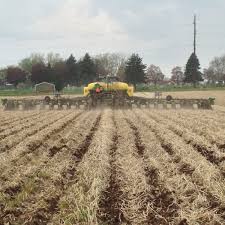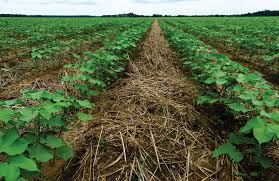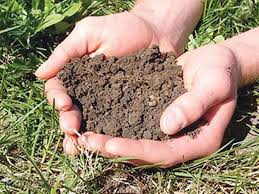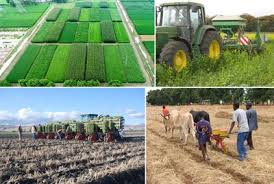Conservation agriculture is a sustainable farming approach that focuses on maintaining soil health, improving water efficiency, and increasing crop productivity while minimizing environmental impacts. It emphasizes three core principles: minimizing soil disturbance, maintaining permanent soil cover, and practicing crop rotation.
By reducing the negative effects of traditional tillage and promoting natural processes, conservation agriculture helps protect natural resources, increase yields, and build resilience against climate change.
Importance of Minimizing Soil Disturbance
Minimizing soil disturbance is one of the key principles of conservation agriculture. Traditional farming practices often involve plowing, tilling, and other forms of soil disturbance, which can lead to soil erosion, reduced soil fertility, and the loss of beneficial organisms. Here’s why reducing soil disturbance is vital:
1. Preventing Soil Erosion: Tilling exposes the soil to wind and water, increasing the chances of soil erosion. By minimizing disturbance, farmers can help keep the soil in place, preserving the topsoil, which is rich in nutrients.
2. Enhancing Soil Structure: Tilling can disrupt the natural structure of the soil, breaking up aggregates that are important for water infiltration and root development. Less disturbance allows soil organisms, such as earthworms, to naturally aerate and improve the soil’s structure.
3. Promoting Soil Microbial Activity: A healthy soil ecosystem includes a diverse range of organisms that play a critical role in nutrient cycling. When soil is left undisturbed, these microorganisms thrive, enhancing soil fertility and reducing the need for synthetic inputs.
4. Conserving Moisture: Minimizing soil disturbance helps retain moisture by preventing water evaporation from exposed soil. This is especially beneficial in dry regions where water conservation is crucial.
The Role of Cover Crops in Soil Health Improvement
Cover crops are an essential component of conservation agriculture, providing multiple benefits to soil health. These crops are grown primarily to cover the soil rather than for harvest. Some key roles of cover crops include:
1. Reducing Soil Erosion: Cover crops protect the soil from wind and water erosion by creating a protective layer over the surface. This reduces the loss of topsoil and keeps the soil intact.
2. Adding Organic Matter: When cover crops decompose, they return organic matter to the soil, improving its structure and nutrient content. This boosts soil fertility, making it more productive for future crops.
3. Enhancing Soil Fertility: Certain cover crops, like legumes, have the ability to fix nitrogen from the atmosphere, enriching the soil with this essential nutrient. This reduces the need for chemical fertilizers.
4. Suppressing Weeds: Cover crops outcompete weeds by occupying the soil and shading them, which reduces weed growth without the need for herbicides.
5. Improving Water Retention: Cover crops help maintain soil moisture by reducing evaporation, making the land more resilient during drought periods.
Techniques for Minimizing Soil Disturbance

Implementing techniques that minimize soil disturbance is a core practice in conservation agriculture. These methods ensure that soil health is preserved while still allowing farmers to grow productive crops. Common techniques include:
1. No-Till Farming: No-till farming involves planting crops directly into undisturbed soil without plowing. This approach keeps the soil structure intact and reduces erosion, enhances water retention, and boosts organic matter.
2. Strip-Till Farming: Strip-till is a compromise between conventional tillage and no-till farming. In this method, only narrow strips of soil where the crops will be planted are tilled, while the rest of the field remains undisturbed. This reduces overall soil disturbance while allowing for precision planting.
3. Mulching: Applying organic or synthetic mulch to the soil surface helps protect the soil, suppress weeds, and reduce moisture loss. Mulching also reduces the need for tilling to manage weeds.
4. Direct Seeding: Direct seeding allows farmers to plant seeds without plowing the soil. Special machinery is used to insert seeds into the soil while minimizing disruption to the soil structure.
5. Agroforestry: The integration of trees and shrubs into farming systems reduces the need for frequent soil disturbance. Tree roots help stabilize the soil, reduce erosion, and contribute to nutrient cycling.
Read Also: Importance of a Sick Bay in a Ruminant House
Benefits of Using Cover Crops in Conservation Agriculture

Cover crops play a crucial role in conservation agriculture by enhancing soil health, improving crop productivity, and providing environmental benefits. They are planted primarily to protect and enrich the soil rather than for harvest. Below are the key benefits of using cover crops:
1. Soil Erosion Prevention: Cover crops form a protective layer over the soil, preventing erosion from wind and water. This is particularly important in areas prone to heavy rainfall or strong winds, where exposed soil can easily wash away or degrade.
2. Organic Matter Addition: When cover crops die and decompose, they return essential organic matter to the soil, which improves its structure, increases water retention, and boosts fertility for the next crop cycle.
3. Weed Suppression: Cover crops compete with weeds for light, nutrients, and water, reducing the need for herbicides. This natural weed control helps lower production costs and minimizes chemical inputs.
4. Nitrogen Fixation: Leguminous cover crops, such as clover and beans, can fix nitrogen from the atmosphere into the soil. This enriches the soil with essential nitrogen, reducing the need for synthetic fertilizers and improving crop yields.
5. Improved Water Retention: Cover crops reduce soil compaction and improve its ability to retain water. This helps crops survive during periods of drought and reduces the need for irrigation.
6. Biodiversity Promotion: The use of diverse cover crops supports a wide range of beneficial organisms, including insects, birds, and soil microbes, creating a healthier and more resilient ecosystem.
Key Principles of Conservation Agriculture
Conservation agriculture is based on three fundamental principles that help preserve soil health, increase productivity, and reduce environmental degradation:
1. Minimal Soil Disturbance: This principle involves reducing tillage and plowing to protect soil structure and prevent erosion. Minimizing soil disturbance allows natural processes like nutrient cycling and water infiltration to occur more efficiently.
2. Permanent Soil Cover: Keeping the soil covered year-round with cover crops, mulch, or crop residues protects it from erosion, conserves moisture, and suppresses weeds. Permanent cover also promotes biological activity within the soil, enhancing fertility over time.
3. Crop Rotation and Diversity: Rotating crops and incorporating a variety of species into the farming system helps prevent pests and diseases, reduces reliance on chemical inputs, and improves soil nutrient balance. Crop diversity also fosters biodiversity, which is essential for a healthy ecosystem.
Read Also: Stocking Management for Ruminant Animals
Long-term Impacts on Soil Structure and Fertility

Conservation agriculture has long-term positive effects on soil structure and fertility, which directly contribute to sustainable farming. These impacts include:
1. Improved Soil Aggregation: The absence of frequent tilling allows soil particles to bond together, forming stable aggregates. This improves soil structure, making it more resistant to erosion and compaction.
2. Enhanced Water Infiltration and Retention: A well-structured soil with organic matter and cover crops allows water to penetrate deeper and be stored in the root zone. This reduces surface runoff and helps plants access water during dry periods.
3. Increased Organic Matter: Over time, cover crops and crop residues decompose and increase the organic content of the soil. Organic matter enhances soil fertility, provides a reservoir of nutrients, and improves the soil’s capacity to store water and air.
4. Enriched Soil Microbial Activity: A healthy soil structure promotes the growth of beneficial microorganisms, such as bacteria, fungi, and earthworms, which play vital roles in breaking down organic material and releasing nutrients for crops.
5. Reduced Dependency on Chemical Inputs: Conservation agriculture reduces the need for synthetic fertilizers and pesticides, as the soil becomes more fertile and resilient through natural processes like nitrogen fixation and pest suppression.
Challenges and Solutions in Implementing Conservation Agriculture
While conservation agriculture offers many benefits, its implementation comes with some challenges. Below are the key challenges and possible solutions:
1. Initial Costs of Transition: Switching from conventional to conservation agriculture often involves costs for specialized equipment, cover crop seeds, and training.
Solution: Governments and agricultural organizations can provide financial assistance, subsidies, or low-interest loans to farmers to help offset initial costs. Offering training programs and knowledge-sharing platforms can also support farmers during the transition.
2. Labor and Management Requirements: Conservation agriculture requires careful management of cover crops, crop rotation, and soil cover, which can increase labor demands and complexity for farmers.
Solution: Introducing mechanized tools for seeding, cover crop planting, and no-till farming can reduce labor intensity. Additionally, providing training on efficient management practices can help farmers adapt to the new system.
3. Weed Control Without Herbicides: Without tilling or chemical herbicides, managing weeds can be more challenging for farmers.
Solution: Cover crops, mulching, and crop rotation can naturally suppress weed growth. Implementing precision farming techniques and biological weed control can also help manage weeds effectively without herbicides.
4. Risk of Pest and Disease Outbreaks: Some farmers worry that leaving crop residues on the field or using cover crops may attract pests and diseases.
Solution: Practicing crop rotation and selecting pest-resistant varieties of crops can reduce the risk of outbreaks. Integrated Pest Management (IPM) strategies can also be used to monitor and control pest populations naturally.
5. Limited Access to Knowledge and Resources: In some regions, farmers may lack access to the necessary knowledge, technology, or financial resources to implement conservation agriculture.
Solution: Governments and NGOs can play a crucial role by investing in agricultural extension services, research, and technology transfer programs. This will ensure that farmers are equipped with the knowledge and tools they need to succeed.
6. Soil Type and Climate Challenges: Not all soils and climates are equally suitable for certain conservation agriculture techniques, such as no-till farming.
Solution: Farmers can adopt a flexible approach by adapting conservation techniques to local conditions. For instance, they might use strip-till or reduced-till methods in areas where no-till farming is not suitable. Tailoring cover crop selection based on climate and soil type is also essential.
Conservation agriculture is vital for promoting sustainable farming while maintaining soil health and reducing environmental impact. By minimizing soil disturbance, using cover crops, and adopting specific techniques like no-till farming, farmers can enhance soil productivity and protect natural resources.
These methods not only improve long-term agricultural sustainability but also help combat the negative effects of climate change and ensure food security for future generations.
Do you have any questions, suggestions, or contributions? If so, please feel free to use the comment box below to share your thoughts. We also encourage you to kindly share this information with others who might benefit from it. Since we can’t reach everyone at once, we truly appreciate your help in spreading the word. Thank you so much for your support and for sharing!
Read Also: Stocking Management for Ruminant Animals

